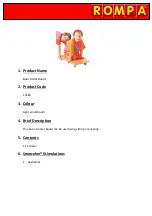
SAFETY ADVICES
As with any mechanical component, a vehicle is subject to high stress and wear.
Various materials and components can react to wear or fatigue differently. If you exceed the expected life of a component, it can suddenly rupture and risk
injury to the user. Cracks, scratches and discolorations in high stress areas indicate that the component has exceeded its service life and should be replaced.
»EN 17128: 2020 (E) 63 city traffic means crossing many obstacles, such as sidewalks or steps. It is recommended to avoid show jumping. It is important to
anticipate and adapt your trajectory and speed to those of a pedestrian before crossing these obstacles. It is also recommended to get out of the vehicle
when these obstacles become dangerous because of their shape, their height or the risk of skidding they present. Keep the plastic protection out of the reach
of children to avoid any risk of suffocation. For inflatable tires, take the time to learn the basics of the practice to prevent a serious accident from occurring
in the first few months. Avoid high traffic areas or congested areas; in all cases, anticipate its trajectory and speed while respecting the highway code, the
pedestrian code and the most vulnerable people; signal their presence when approaching a pedestrian or cyclist who may not have seen or heard the vehicle;
walk through protected passages; in all cases, pay attention to yourself and others; do not divert the vehicle from its initial use; this vehicle is not intended for
acrobatic use; beware, the brake may heat up when used. Do not touch it after use; regularly check the tightening of the various bolted elements, in particular
the wheel axles, the folding system, the steering system and the brake axle; eliminate the sharp edges generated by use; do not modify or modify the vehicle,
including the steerer tube and sleeve, stem, folding mechanism and rear brake.
SAFETY INSTRUCTIONS AND WARNINGS
REMINDER OF THE PRECAUTIONS BEFORE DRIVING:
• Always wear a helmet and other body protection� Drive safely�
• Get to know your vehicle and practice riding the electric scooter before you hit the road� Remember to select the driving mode that suits you�
In order to deal with sudden situations, be prepared to slow down by holding the brake at all times�
• Before turning, consider slowing down�
• During road obstacles, be sure to slow down�
• Do not take stony paths or roads in poor condition�
• Learn how to use the front brake: most of the braking power comes from the front brake�
• Be careful because there is a risk of burns due to the heat of the engine and the brakes (in particular the brake disc and its caliper) after use�
• Please always use two hands to hold the handlebars and pay attention to road conditions as well as traffic conditions.
• Do not ride with the kickstand down�
• Do not wear earbuds, headphones or earphones while driving�
• Never drive under the influence of drugs or alcohol. Stay in control of your actions on the road.
• You are fully responsible for physical and material injuries in the event of an accident�
• Always obey the laws of the country in which you are driving�
USER MANUAL - EN
19
Содержание BURN-E
Страница 1: ...usermanuel...
Страница 2: ...English version...
Страница 4: ......
Страница 32: ...Version fran aise...
Страница 34: ......
Страница 62: ...TRAVELOGUE CARNET DE ROUTE 62 MANUEL D UTILISATION FR...
Страница 63: ...TRAVELOGUE CARNET DE ROUTE MANUEL D UTILISATION FR 63...
Страница 64: ...NAMI ELECTRIC COM Power reliability design...
















































